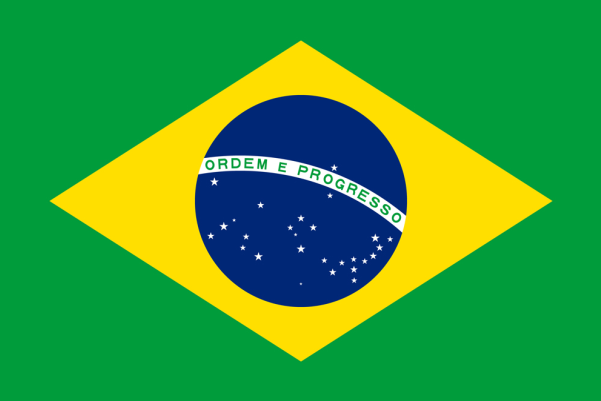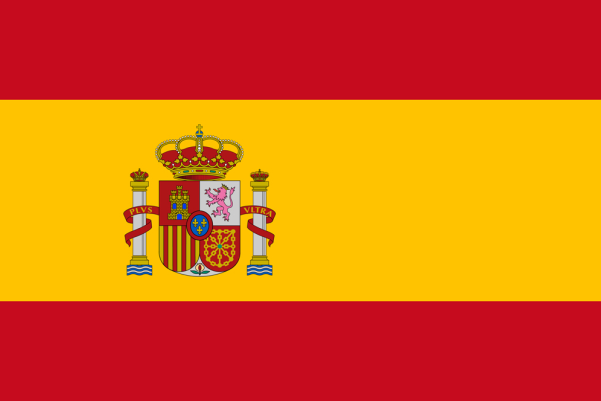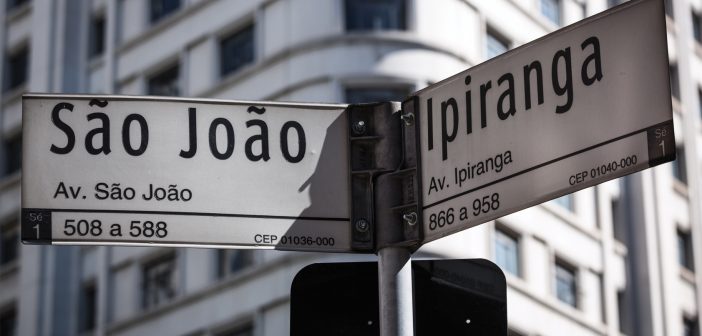São Paulo, despite being the principal gateway to Latin America, remains relatively unexplored as a tourist destination, often overshadowed by the curvaceous beaches and picture-postcard setting of Rio de Janeiro.
But LATAM’s answer to the Big Apple has much to offer. Leave your bucket and spade at home and give São Paulo 24 hours to show you that Brazil is more than just sun, sea and sand.
6am
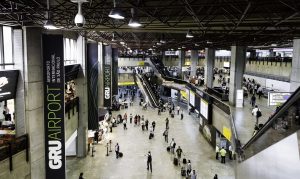 Things get going early and direct flights from the UK arrive at dawn. Portuguese is the local tongue, but no matter, a vivacious Brazilian welcome at Cumbica airport awaits. Also known as Guarulhos, the ground-staff love nothing more than a spot of gesticulation at sunrise, and it is with this clumsy but good-natured communication that your Sampa adventure begins. Taxis are the best bet for transfers, while a number of shuttle bus services can get you to different points of the city.
Things get going early and direct flights from the UK arrive at dawn. Portuguese is the local tongue, but no matter, a vivacious Brazilian welcome at Cumbica airport awaits. Also known as Guarulhos, the ground-staff love nothing more than a spot of gesticulation at sunrise, and it is with this clumsy but good-natured communication that your Sampa adventure begins. Taxis are the best bet for transfers, while a number of shuttle bus services can get you to different points of the city.
The road really is the only option for the 25km-run into town, the start of which is flanked by a series of colossal construction works that pledge to deliver a fast-track rail link to the airport; this is a city going places. Progress may only be temporary for now, however, especially on weekdays as São Paulo’s commuter congestion is notorious. Either way, the busy Marginal highway, the city’s principal artery, affords passengers a captivating window to the largest city in the Southern Hemisphere.
The wispy, early-morning mist boasts a cloud-like quality, indicative of São Paulo’s surprising altitude – 800 metres above sea level – as motorcyclists, known as motoboys – courageously slalom the gridlock. Trains creep quietly along the riverside tracks, their steamed windows and relative infrequency suggestive of why car is king in this town. The favelas, or shantytowns, punctuate the looming cityscape and serve as a sharp reminder of Brazil’s “developing” status, but also hint to the alluring conviviality that underpins the infectious Brazilian spirit. Even amidst such disparity there is solidarity, perhaps best illustrated by the hearty haggle of street vendors flogging anything from phone chargers to fresh popcorn. São Paulo is a fertile ground for the entrepreneur.
8.30am
Yes, it really can take 90 minutes to reach downtown. The peripherals give way to towering high-rises and shiny office complexes. The city’s fleet of helicopters – the largest in the world – buzz overhead with neck-straining regularity whilst air traffic controllers juggle the steady stream of planes making their final approach to the city’s other airport, Congonhas.
 Getting about in this megacity is hungry work and there’s no better place to fuel up than a local padaria (bakery). To call them bakeries, however, betrays their impressive spread; they are more akin to American diners, fitted with traditional countertop displays showcasing a puzzling array of sweet and savoury snacks; pão de queijo (cheese bread), coxinhas (shredded chicken encased in a shell of breaded potato) and quibe (fried meat patties). There are healthier temptations too, including a mouth-watering range of freshly-squeezed juices and tropical smoothies. They do, pleasingly, sell a belt-busting assortment of freshly-baked bread and pastries, including pãezinhos (“little” bread rolls), a breakfast staple in these parts that is customarily washed down with a short, strong expresso.
Getting about in this megacity is hungry work and there’s no better place to fuel up than a local padaria (bakery). To call them bakeries, however, betrays their impressive spread; they are more akin to American diners, fitted with traditional countertop displays showcasing a puzzling array of sweet and savoury snacks; pão de queijo (cheese bread), coxinhas (shredded chicken encased in a shell of breaded potato) and quibe (fried meat patties). There are healthier temptations too, including a mouth-watering range of freshly-squeezed juices and tropical smoothies. They do, pleasingly, sell a belt-busting assortment of freshly-baked bread and pastries, including pãezinhos (“little” bread rolls), a breakfast staple in these parts that is customarily washed down with a short, strong expresso.
Avenida Paulista denotes the CBD. There are other important commercial hubs, but this is where the heartbeat of Latin-American commerce beats loudest. This is Brazil’s ode to Manhattan; the Land of Liberty’s influence is omnipresent. Despite the historical ties with Portugal and the hallmarks of early-European colonialization, SP is a city with a soft spot for Uncle Sam and his cultural persuasions.
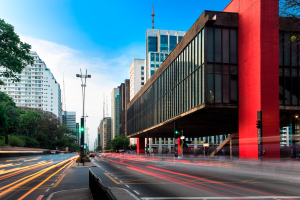 It is also home to MASP, São Paulo’s much-celebrated museum of modern art. The building itself – with its imposing postmodern design – is emblematic of mid-twentieth-century Brazilian architecture, a movement that was somewhat suppressed by the military dictatorship (1964-1985). The museum is a symbol of defiant artistic expression and hosts the largest collection of western art in the southern hemisphere, with over 8,000 paintings, sculptures, drawings and decorative arts in total (Av. Paulista, 1578, www.masp.art.br).
It is also home to MASP, São Paulo’s much-celebrated museum of modern art. The building itself – with its imposing postmodern design – is emblematic of mid-twentieth-century Brazilian architecture, a movement that was somewhat suppressed by the military dictatorship (1964-1985). The museum is a symbol of defiant artistic expression and hosts the largest collection of western art in the southern hemisphere, with over 8,000 paintings, sculptures, drawings and decorative arts in total (Av. Paulista, 1578, www.masp.art.br).
10.30am
Time for a mid-morning stroll. Jardins, only a short walk from MASP, is one of the city’s most-coveted des res neighbourhoods and is lavishly served by the trendy Rua Oscar Freire. Whatever your budget, São Paulo’s very own Greenwich Village – with its vibrant boutiques and café culture – is a people-watching paradise. Any number of quaint establishments will serve you a punchy coffee, but if you’re craving elevenses head to the Galeria dos Pães (Bread Gallery) – another den of decadence masquerading under the guise of a bread-maker (Rua Estados Unidos, 1645, www.galeriadospaes.com.br). Be sure to visit the flagship Havaiana store (Rua Oscar Freire, 1116) – the kaleidoscopic collection of flip-flop designs and customisable accessories is enough to tickle anyone’s fancy.
11.30am
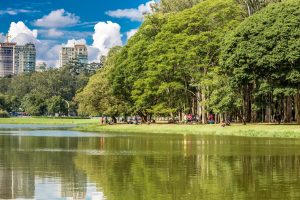 With midday sun imminent, find the nearest ponto de táxi (taxi rank) and head for the city’s most central oasis, Ibirapuera Park, where you’ll find several iconic buildings and museums, many designed by the legendary Oscar Niemeyer, the godfather of postmodern Brazilian architecture and chief protagonist in the planning of the nation’s capital, Brasilia. The park is replete with lakes, fountains, monuments, playgrounds, cycle lanes, and other amenities. The exotic plants and fauna transport visitors to a time of undiscovered equatorial lands, a horticultural haven of sanctum and tranquillity for its legions of loyal patrons; green spaces are sacred in this urban jungle. A leisurely trot around the park takes about 90 minutes (www.parquedoibirapuera.com).
With midday sun imminent, find the nearest ponto de táxi (taxi rank) and head for the city’s most central oasis, Ibirapuera Park, where you’ll find several iconic buildings and museums, many designed by the legendary Oscar Niemeyer, the godfather of postmodern Brazilian architecture and chief protagonist in the planning of the nation’s capital, Brasilia. The park is replete with lakes, fountains, monuments, playgrounds, cycle lanes, and other amenities. The exotic plants and fauna transport visitors to a time of undiscovered equatorial lands, a horticultural haven of sanctum and tranquillity for its legions of loyal patrons; green spaces are sacred in this urban jungle. A leisurely trot around the park takes about 90 minutes (www.parquedoibirapuera.com).
12.30-2pm
Lunchtime is not to be scoffed at in São Paulo. If wolfing down a store-bought sandwich is your usual fare then you’re in for a shock. Brazilian cuisine is diverse, intriguing and demands time; often more than a lunch “hour” permits. Whilst São Paulo has most world foods covered, Brazilian cooking catalogues a host of novel dishes, many of which come loaded with cultural significance. None more so than the national luncheon, feijoada (meat and black bean stew), which was traditionally served to slaves (offcuts and trimmings), but has since been elevated to the status of a midweek must normally served on Wednesdays (and Saturdays). It usually comes with a side dish of farofa, a local take on stuffing, which is made with a cassava flour mixture and washed down with cut orange. It is São Paulo on a plate; unique, moreish and bursting with flavour.
With so many options it is little wonder that many locals opt for por kilo (by kilo), Brazil’s very own solution to buffet dining. Restaurants offer an impressive choice of colourful salads and hot dishes and you simply pay by the weight of your plate. It is a healthy approach to eating out and caters for all tastes and budgets. Quality and price vary, but for por kilo at its best look no further than Restaurante Laportes (Rua Urussuí, 320, Itaim Bibi – www.laportes.com.br).
2.30-5.30pm
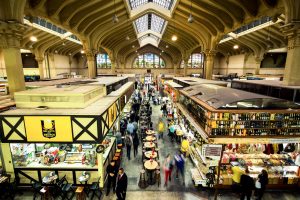 Replenished, it is time to stave off any creeping jetlag with some retail therapy. São Paulo has it all, from crafty market stalls to opulent shopping malls. A shimmy along the Rua25 de Março (São Bento metro station – blue line) is a must for the culturally-curious shopper. From toys to fake handbags to fabrics to jewellery, low prices draw in the crowds looking to snag a bargain. It is chaotic, but fun. Liberdade (blue line) is the city’s Japanese district and has a more Camden-Market approach to deal-hunting, as friendly shopkeepers beguile passers-by with their emporiums of kitsch gifts and trinkets. The region is also a mecca for sushi affectionate and has spawned an insatiable demand for the Japanese delicacy across the city. If seafood isn’t your thing, however, take a short trip to the municipal market – known affectionately as the Mercadão – for a memorable induction to local grocery shopping. A hanger-sized indoor market – 35,000 square feet – unites a sea of traders bartering every foodstuff under the sun. Stalls also offer irresistible refreshments; the mortadella sandwich usually high on any tourist to-do list and a tasty spin on fast food (Rua da Cantareira, 306).
Replenished, it is time to stave off any creeping jetlag with some retail therapy. São Paulo has it all, from crafty market stalls to opulent shopping malls. A shimmy along the Rua25 de Março (São Bento metro station – blue line) is a must for the culturally-curious shopper. From toys to fake handbags to fabrics to jewellery, low prices draw in the crowds looking to snag a bargain. It is chaotic, but fun. Liberdade (blue line) is the city’s Japanese district and has a more Camden-Market approach to deal-hunting, as friendly shopkeepers beguile passers-by with their emporiums of kitsch gifts and trinkets. The region is also a mecca for sushi affectionate and has spawned an insatiable demand for the Japanese delicacy across the city. If seafood isn’t your thing, however, take a short trip to the municipal market – known affectionately as the Mercadão – for a memorable induction to local grocery shopping. A hanger-sized indoor market – 35,000 square feet – unites a sea of traders bartering every foodstuff under the sun. Stalls also offer irresistible refreshments; the mortadella sandwich usually high on any tourist to-do list and a tasty spin on fast food (Rua da Cantareira, 306).
If a more conventional browse is your fancy then there is no shortage of American-style shopping malls. Whether you’re panging for Prada or Primark, there’s something for everyone. Each centre comes equipped with diverse food halls, adjoining cinemas and ample parking, and given that they generally stay open until 10 pm they effectively serve as a one-stop-shop for most leisurely pursuits. Shopping Cidade Jardim (Av. Magalhães de Castro, 12000, Cidade Jardim) offers the best of high-end fashion and luxury, as well as a selection of excellent restaurants. Eldorado Shopping (Av. Rebouças, 3970, Pinheiros) blends a good mix of high-street retail and entertainment.
Time allowing, also try:
Museu do futebol (Football Museum)
The museum is housed in the Paulo Machado de Carvalho Municipal Stadium – better known as Pacaembu. The museum reveals how football has evolved in Brazil to become one of the more cherished manifestations of Brazilian identity. To understand football in Brazil is to understand its people and how they are forever married to “the beautiful game”.
More info: Praça Charles Miller, Pacaembú – www.museudofutebol.org.br
Pinacoteca do Estado de São Paulo /Estação de Luz
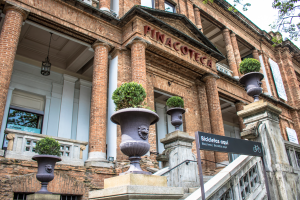 Pinacoteca do Estado de São Paulo is the oldest art museum in São Paulo and prized for its collection of nineteenth-century paintings and sculptures. The Pinacoteca is a stone’s throw from the Estação de Luz (Luz Station), in the heart of the Luz neighbourhood. The grandiose station was inaugurated in the late nineteenth century and remains fully operational today. It was designed by the British and was, believe it or not, built-in Glasgow before being dismantled and shipped to Brazil.
Pinacoteca do Estado de São Paulo is the oldest art museum in São Paulo and prized for its collection of nineteenth-century paintings and sculptures. The Pinacoteca is a stone’s throw from the Estação de Luz (Luz Station), in the heart of the Luz neighbourhood. The grandiose station was inaugurated in the late nineteenth century and remains fully operational today. It was designed by the British and was, believe it or not, built-in Glasgow before being dismantled and shipped to Brazil.
More info: Pinacoteca – Praça da Luz, Luz
Igreja Nossa Senhora do Brasil
Given that the country remains predominantly Catholic, religious symbolism and places of worship are commonplace throughout São Paulo. Igreja Nossa Senhora do Brasil (Church of Our Lady of Brazil) is one of the more preeminent, with its baroque-style design and impeccable fresco paintings, reproductions of those found in the Sistine Chapel.
More info: Praça Nossa Senhora do Brasil, Jardim Paulista
6pm
 For all your other recreational needs, nightfall lifts the curtain on a world of possibilities. A popular haunt for a dose of caipirinha clutching is Skye, the rooftop bar and restaurant at Hotel Unique (Brigadeiro Luís Antônio, 4700 – www.hotelunique.com.br), which boasts an unparalleled panoramic 360-degree view of the city. Another favourite is Bar Brahma (Avenida São João, 677 – www.barbrahmasp.com) which serves – apart from cold drinks – quintessential Brazilian nibbles like pastéis de carne seca (fried pastry pockets stuffed with dried beef) and provolone milanesa (deep-fried breaded cheese). Legend has it that Caetano Veloso penned his beloved ballad, Sampa, whilst sitting out on the bar’s terrace and enjoying a cold choppe (tap larger).
For all your other recreational needs, nightfall lifts the curtain on a world of possibilities. A popular haunt for a dose of caipirinha clutching is Skye, the rooftop bar and restaurant at Hotel Unique (Brigadeiro Luís Antônio, 4700 – www.hotelunique.com.br), which boasts an unparalleled panoramic 360-degree view of the city. Another favourite is Bar Brahma (Avenida São João, 677 – www.barbrahmasp.com) which serves – apart from cold drinks – quintessential Brazilian nibbles like pastéis de carne seca (fried pastry pockets stuffed with dried beef) and provolone milanesa (deep-fried breaded cheese). Legend has it that Caetano Veloso penned his beloved ballad, Sampa, whilst sitting out on the bar’s terrace and enjoying a cold choppe (tap larger).
For a less formal chinwag with the locals head down to the bohemian district Vila Madalena (green line subway). The neighbourhood is revered for its eclectic mix of bars and casual eateries, most of which spill out onto the pavement. Waiters buzz from table to table-topping up glasses and serving enticing beer snacks. There is an authenticity to the area and during the day the local art galleries and striking graffiti promote an artistic and creative community. Many bars offer live music in the evenings. Be sure to try Bar São Cristovão (Rua Aspicuelta, 533), a time-honoured bar that features fascinating football nostalgia and memorabilia, not to mention a very inviting menu of aged cachaças. For more of a boteco (pub) feel head to Astor, which also has a wonderful cocktail lounge, Subastor, located in its basement (Rua Delfina, 163 – www.barastor.com.br).
Also try:
SP from above – Helicopter ride
Why not take to the skies for a truly unforgettable aerial perspective of São Paulo’s rush hour? A 30-minute flight will cover all the major sights, with running commentary available in English, Spanish and Portuguese.
More information: www.aroundsp.com
9pm
It would be amiss not to experience a churrascaria (steakhouse) whilst in town. Not only is the local meat excellent, but the novel way in which it’s served is exciting. Rodizio – which loosely translates as “rotation” – ensures a truly distinct Brazilian experience. The principle is “eat all you can”, and there is plenty to choose from. Sumptuous salad bars – stocked with tangy cheeses, cured meats, crisp lettuces and seasonal fruits – conspire to steal your appetite at first, but leave room for the main event. Waiters offering succulent slow-cooked meats on skewers waltz around the table at a tempo you determine; a coaster – one side red to keep the servers at bay and one side green to beckon them forthwith – acts as a signal of your hunger. Most establishments offer a staggering variety of cuts, often accompanied by an illustrative guide, but make sure you ask for Picanha (Rump Cap), which despite being the most tender and flavoursome, is not common outside Brazil. Few dispute Fogo de Chão’s (www.fogodechao.com) reign as the premium pick for Rodizio in São Paulo, but there are other more accessible options sure to hit the mark, like Bovinus (www.bovinus.com.br).
Also try:
Terraço Itália
Not for those who suffer vertigo, Terraço Itália is an exclusive Italian restaurant located on the 41st floor of the 46-floor Edifício Itália (Italian Building). The view over the southern reaches of the city is breath-taking. There’s also a bar (Bar do Terraço) located on the 42nd floor. Booking is advised.
More info: Avenida Ipiranga, 344
12am
Brazilians love to dance and São Paulo’s clubbing scene is nothing short of lively -seven days a week – much to the delight of the city’s ballooning student population. Saturday nights draw the biggest crowds with nightclubs peaking by 3-4 am. Many clubs, such as Lion’s Club (www.lionsnightclub.com.br), are located in quirky centrally-located venues, whilst there are neighbourhoods, such as Barra Funda, which offer a cluster of party favourites, such as D-Edge (www.d-edge.com.br) and Club 33 (www.33club.com.br). São Paulo has established itself as an important stop for renowned international DJs and prominent bands.
LGBT
São Paulo is one of the most LGBT-friendly cities in Brazil and every June hosts the largest Gay Pride march in Latin America. LGBT-friendly restaurants, bars, clubs and saunas can be found throughout the city, but most are in the Jardins area. Farol Madalena (RuaJericó, 179) is a fashionable hangout with the local community, but the biggest blowout is at The Week (Rua Guaicurus, 324), one of the most notorious gay clubs in Brazil.
Like its North American cousin, São Paulo really is a city that “never sleeps”. Whether people are clocking on or off, there is always something happening. It is nothing short of energising. With so much on offer 24 hours won’t scratch the surface, but it will leave you wanting more. Those staying longer or already planning a return trip will also find plenty to do beyond the city.
Beyond São Paulo
The wider State of São Paulo offers other attractions, including the largest seaport in Latin America, the historical city of Santos. It is about a 90-minute drive, taking the Rodovia Imigrantes (SP-180), a steep descent towards the coast via a series of tunnels, bridges and viaducts. The British-owned São Paulo Railway used to transport coffee to the port for shipping, and this legacy is no better understood than at the Museu do Café (coffee museum), which is housed in the 1922-built Coffee and Commodities Exchange (Santos was one of the world’s major coffee trading centres at the time). More info: Rua XV de Novembro, 95 – www.museudocafe.com.br
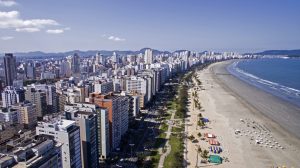 Interestingly, Santos holds the Guinness World Record for the largest beachfront gardens, which run for approximately 7km along the city’s seafront promenade, so pack a decent pair of trainers. Santos is also the official finish line of the infamous, winding coastal road to Rio de Janeiro, the Rodovia Rio-Santos (BR-101), which rewards its drivers with spectacular scenery and access to several idyllic seaside towns along the way, like Maresias and Camburi, in the State of Sao Paulo, and Paraty and Angra dos Reis, in the State of Rio de Janeiro. A more picturesque road trip you will not find.
Interestingly, Santos holds the Guinness World Record for the largest beachfront gardens, which run for approximately 7km along the city’s seafront promenade, so pack a decent pair of trainers. Santos is also the official finish line of the infamous, winding coastal road to Rio de Janeiro, the Rodovia Rio-Santos (BR-101), which rewards its drivers with spectacular scenery and access to several idyllic seaside towns along the way, like Maresias and Camburi, in the State of Sao Paulo, and Paraty and Angra dos Reis, in the State of Rio de Janeiro. A more picturesque road trip you will not find.
Important information
Population: +20million and counting (greater municipality)
Local lingo: Brazilian Portuguese
Portuguese basics
Please – por favor
Thank you – obrigado/obrigada (f)
Could I have – posso ter… uma água (water), um quarto duplo (double room)
Local currency: Brazilian Real
Local culture
Brazilian culture is defined by its people; warm, friendly and extremely welcoming. In general, tourists are received with open arms. English is easy enough to find in hotels and international restaurants, but Spanish is more common as a second language. Brazilian culture opts for a more laisser-faire attitude to timing so British-Esque punctuality is optional. Brazil is a predominantly Catholic society, but São Paulo is increasingly multicultural and all races, creeds and beliefs are represented. Most modern cities wrangle with crime and São Paulo is no exception, but if you keep to the well-trodden track then there is no need for alarm. Taxis/Uber advised after dark.

